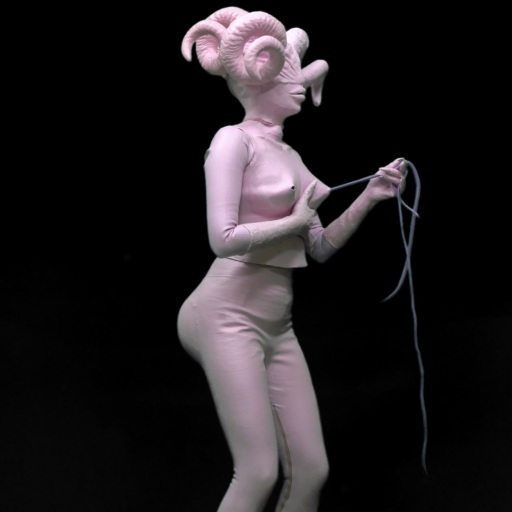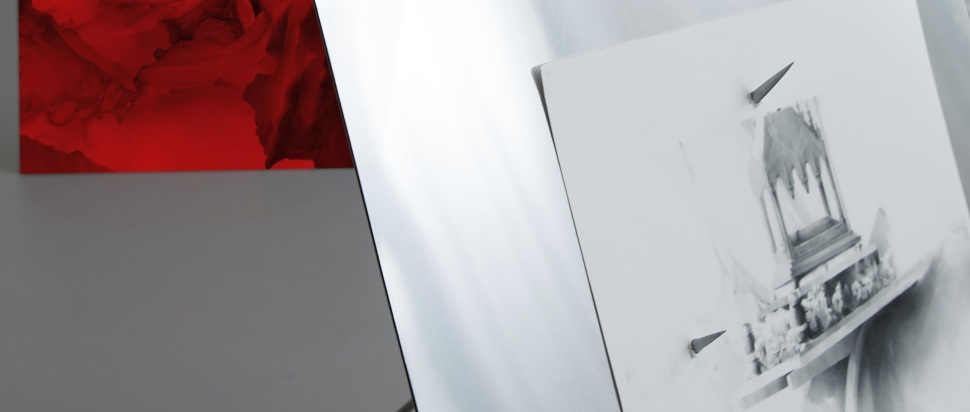GSA Degree Show 2024: Master of Fine Art
Flirting with world-building, modern media, and digital encounters, artists on Glasgow School of Art's MFA are forging depictions of a climate that they recognise as fruitful yet corrupt with imagery and inspiration.
The approaches of Master of Fine Art graduates are varied as ever, yet there is an undeniable vibrancy and an air of refined playfulness across the works on show, signalling the quality of critical thought and material enquiry that has taken place behind the scenes. The building has been brought to life by these artists, as they continue to develop their maturing practices, many continuing bodies of work that have been ongoing for years.
Derived from his own creative writing processes, informed by Scottish literary theory, Chris Farrell paints scenes that present as both fragmented and immersive at once. Farrell’s display consists of four paintings and a film, tucked away beneath a gazebo, with each component being formed around a fictive music festival fabricated by the artist. Considering theories such as Caledonian Antisyzygy (which refers to the idea of duelling polarities within the same entity, applied to the Scottish psyche and literature), Farrell’s writing is the first step in the process that leads him to collect images from various digital sources and to collage then paint environments that, despite their seemingly disparate contents, render each component as far from incongruous. The works ring true to the experiences of any Scottish music festival, with the familiar imagery rendering something humorous yet slightly unnerving.
Holly O’Brien constructs a hybrid between the mythological and the digital, through an installation of projected video works that depict the artist in costumes, including two full-body latex pieces. The videos exude something reminiscent of avatars occupying the loading screen of a video game and feel simultaneously alive yet artificial. O’Brien allows an extended visual language to be absorbed into the body of work, blending imagery from a variety of platforms that might play a role in the forming of a new collective unconsciousness, such as social media, pornography, and video games. O’Brien’s work continues upstairs, directly above the videos, with a vibrant and gelatinous installation which appears to seep through the floorboards and into the space below.
Also working in the gap between various forms of media, Cora Weiss’s work Tempo manifests as a rhythmic and curatorially engaged dispersal of imagery, derived from media consumed by the artist. Considering the mass influx of imagery we are met with daily, Weiss is attentive to placement, seeking to map out hierarchies and inequalities between images, considering the time spent engaging with what we see.

Image: Holly O'Brien.
Neighbouring Weiss’s work are Louise Campion's vibrant oil paintings, which portray her exploration of the corporate world through a somewhat subverted aesthetic, reflecting what she calls the "attractive value of greed." Campion's work is dominated by imagery that evokes ideas of positions of power within corporate contexts, exploring the pedestals on which we place figures of authority. Elements of homoeroticism arise in the work, and the underlying sense of beauty lends the paintings a strong aesthetic quality which displays a striking dichotomy with the expected dryness of a corporate aesthetic. Overall, challenging and reframing our perceptions of power and success in corporate environments, through an unexpected relationship between subject matter and visual language.
Aaron Alexander Smyth’s flaming flowers that brightly blaze and a way a lone a last a loved a long is an interdisciplinary work that explores how our experience is visually coded within systems of power. Narrating a personal ceremonial journey through imagery, Smyth intertwines his experience with the broader sociohistorical relationship with the transcendental – grief and absence are portrayed as markings we carry with us through life.
Zeena Wright-Al Tai has staged a dramatised retelling of an episode of psychosis, forging a world that sits on the cusp of something haunting yet beautiful, troubling yet intriguing. The artist approaches the idea of an immersive environment in a different way, inviting the viewer to peer into a sewn tent that contains a set that might be from a shadow puppet theatre. A motorised ring of trees and fluttering moths form the body of the work, enticing the viewer. Adding to its atmospheric nature, these elements are accompanied by a soundscape by sound engineer (Olli) Olivier Jean Julien, featuring harp by Dara Watson. The entwining of textile-based and sculptural elements contribute to a unique experience, as the viewer is both immersed in the work and an onlooker on a depiction of mental illness that is often stigmatised.
With their Degree Show taking place across the industrial interior of the Glue Factory, this year’s MFA graduates have presented an exhibition of work that seeps its way into every facet of the imagination.
Master of Fine Art, Glue Factory, 30 May-9 June
